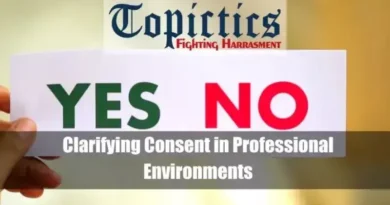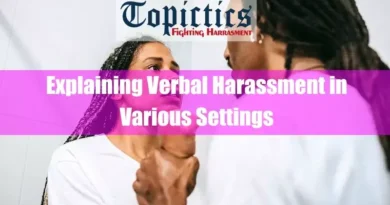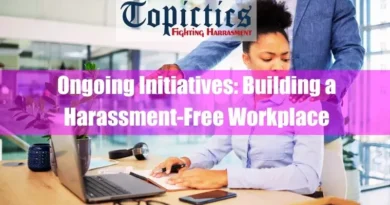I. Introduction
Have you ever felt unsafe because of someone’s unwanted behavior? Someone may have followed you too closely, made inappropriate comments, or sent you nasty messages online. If so, you’ve experienced harassment, a pervasive issue that unfortunately touches too many lives. In this article, we’ll delve into the different forms of harassment – physical, visual, and online – and their impact on individuals and how to recognize and respond effectively.
A. Defining Physical, Visual, and Online Harassment
1. Physical Harassment:
Physical harassment involves unwanted physical contact that disrupts someone’s sense of safety or well-being. This can range from shoving, hitting, or grabbing to stalking or destruction of property. It can occur anywhere but is often seen in situations where someone feels they have power over another person, like a bully at school or a domestic abuser.
2. Visual Harassment:
Visual harassment refers to unwanted visual stimuli that make someone feel uncomfortable or unsafe. This can include displaying offensive images or objects, like pornography or hateful symbols. It can also involve offensive gestures or intrusive staring. Visual harassment can occur in person, but it’s also becoming more common online.
3. Online Harassment:
Online harassment is using electronic communication to bully, threaten, or embarrass someone. It can take many forms, such as sending hateful messages, spreading rumors, or posting embarrassing photos without someone’s consent. Online harassment can be particularly harmful because it can follow someone everywhere they go online, and it can be challenging to escape.
Harassment, a multi-headed beast with physical threats, unwanted visuals, and online negativity (leering, stalking, cyberbullying), can cause lasting harm. Let’s delve deeper to understand its forms, impact, and strategies to combat it, creating a safer and more respectful world together.
II. Physical Harassment: The Unwanted Touch of Fear

Let’s focus on the most tangible form of harassment: physical harassment. The uninvited touch, the aggressive shove, and the chilling proximity make your skin crawl. It can range from seemingly minor incidents like unwanted touching or pinching to blatant physical assaults, stalking, and sexual violence.
A. Forms of Physical Harassment:
- Direct assault: Hitting, pushing, grabbing, kicking, and other forms of physical aggression.
- Intimidation and stalking: Following someone, blocking their movement, making threatening gestures, or invading their personal space.
- Sexual harassment and assault: Unwanted sexual advances, touching, groping, or forced sexual acts.
- Restrictions on movement and freedom: Confining someone, preventing them from leaving a situation, or controlling their physical access to places or people.
B. Impact on Victims:
The physical and emotional toll of physical harassment can be devastating. Victims often experience:
- Physical injuries: From bruises and cuts to more serious harm, depending on the severity of the assault.
- Emotional trauma: Fear, anxiety, depression, and post-traumatic stress disorder (PTSD) are common consequences.
- Loss of self-esteem and safety: Feelings of powerlessness, vulnerability, and distrust can affect their confidence and sense of security.
- Social isolation: Victims may withdraw from social activities or avoid certain places due to fear.
C. Recognizing and Reporting Physical Harassment:

It’s crucial to recognize the red flags of physical harassment:
- Unwanted physical contact of any kind.
- Feeling unsafe or threatened by someone’s behavior.
- Repeatedly being followed or monitored.
- Being pressured or coerced into sexual activity.
If you experience any of these, reporting the incident is crucial. Here are some options:
- Reporting to authorities: Contact the police immediately if you’re in immediate danger or have experienced a serious assault.
- Reporting to school, workplace, or community organizations: Many institutions have reporting procedures and support systems for victims.
- Seeking professional help: Therapists and counselors can offer support and guidance in dealing with the trauma of physical harassment.
- Bystander Intervention:Remember, you’re not alone. If you witness physical harassment, you can be a powerful ally:
- Speak up: Directly challenge the behavior if it’s safe to do so.
- Report the incident: Notify authorities or relevant organizations.
- Offer support to the victim: Show empathy and let them know they’re not alone.
Remember, physical harassment is never acceptable. By understanding its forms, impact, and ways to respond, we can create safer spaces and empower ourselves and others to resist it. Stay tuned as we delve deeper into other forms of harassment and explore ways to fight for a world free from fear and intimidation.
Related articles:
- Understanding Power Dynamics
- Demystifying Sexual Advances: Beyond Yes or No
- Cultural Norms and Harassment: Understanding the Link
III. Visual Harassment: The Unwanted Gaze and Unseen Harm

Imagine the discomfort of feeling someone’s unwelcome gaze lingering on your body or the violation of having personal photos shared without your consent. This is the unfortunate reality of visual harassment, a form of abuse that uses visuals to objectify, intimidate, and belittle. Let’s unpack its various forms and understand its impact on individuals.
A. Forms of Visual Harassment:
- Unwanted sexualized staring, leering, and gestures: Fixating someone’s body, making suggestive facial expressions, or using obscene hand gestures can create a hostile and unsafe environment.
- Taking or sharing non-consensual photos or videos: Capturing or distributing images or recordings of someone without their permission is a serious invasion of privacy and can be used for further harassment or exploitation.
- Displaying offensive or degrading images: Posting or displaying sexually suggestive, discriminatory, or otherwise offensive images can create a toxic environment and contribute to a culture of harassment.
- Cyberflashing and other online visual invasions: Sending unsolicited explicit images or videos, hacking into someone’s webcam, or engaging in other unwanted visual intrusions online are forms of cyberbullying and harassment.
B. Impact on Victims:
Similar to physical harassment, visual harassment can have a profound impact on individuals, including:
- Feeling violated and objectified: The unwanted focus on physical appearance can lead to feelings of shame, discomfort, and loss of control.
- Fear and anxiety: Constant scrutiny and potential for humiliation can trigger anxiety and fear of public spaces.
- Damage to self-esteem and confidence: Feeling objectified and unsafe can affect a person’s self-worth and confidence in social interactions.
- Increased risk of cyberbullying and stalking: Shared visual content can fuel further online harassment and stalking, exacerbating the harm.
C. Recognizing and Reporting Visual Harassment:
Identifying these red flags can help you recognize visual harassment:
- Uncomfortable stares, leering, or suggestive gestures that make you feel unsafe.
- Unauthorized pictures or videos taken or shared without your consent.
- Exposure to offensive or discriminatory images in personal or public spaces.
- Unwanted explicit content sent online or through other digital means.
Reporting visual harassment is essential to stop the perpetrator and empower yourself:
- Document the incident: Take screenshots, save messages, or note down details whenever possible.
- Report to authorities: If the harassment involves illegal activity, such as cyberflashing or sharing explicit content, report it to the police.
- Report to platforms or institutions: Report the incident to the platform where it occurred or to relevant authorities like schools, workplaces, or community organizations.
- Seek support: Talk to trusted friends, family, or counselors for emotional support and guidance.
D. Strategies for Prevention:
While individual action is crucial, creating a culture of respect and consent is key to preventing visual harassment:
- Challenge objectification and inappropriate behavior: Speak up against sexist comments and unwanted gazes safely and appropriately.
- Advocate for privacy and consent: Promote understanding of the importance of consent in taking and sharing pictures and videos.
- Report platforms and websites: Hold digital platforms responsible for addressing and preventing visual harassment effectively.
By recognizing the harmful effects of visual harassment and taking action to stop it, we can create a safer and more respectful environment for everyone. Remember, you are not alone, and your voice matters. Stay tuned for the next part, where we delve into the complexities of online harassment and how to navigate the digital landscape safely and confidently.
Related articles:
- The Role of Empathy in Harassment
- How to Provide Anti-harassment Training in the Workplace
- How to Provide Anti-harassment Training in Schools
- Fostering a Culture of Respect and Open Communication
IV. Online Harassment: The Invisible Sting in the Digital Age

The internet, a vast sea of information and connection, can also harbor darker currents of negativity. Online harassment, leveraging the anonymity and pervasiveness of the digital world, inflicts pain and fear on individuals both directly and indirectly. Let’s dive into its various forms and understand the impact it leaves on its victims.
A. Forms of Online Harassment:
- Cyberbullying and online hate speech: Spreading malicious rumors, sending threatening messages, posting offensive content, and targeting individuals with hate speech are common tactics.
- Doxing and impersonation: Revealing someone’s personal information online or creating fake accounts to spread misinformation or damage their reputation are serious forms of harassment.
- Spreading rumors and disinformation: Fabricating and sharing false information about someone online can damage their social standing and professional life.
- Using technology for stalking and tracking: Monitoring someone’s online activity, using spyware, or threatening them with information gathered online are forms of cyberstalking.
B. Impact on Victims:
The anonymity and constant nature of online harassment can create unique challenges for victims:
- Amplified emotional distress: The feeling of being constantly targeted and the potential for the harassment to reach a wide audience can lead to severe anxiety, depression, and even suicidal ideation.
- Damage to reputation and online presence: Negative content can persist online, impacting future opportunities and social interactions.
- Potential for real-world consequences: Online harassment can escalate into offline threats and harm, creating fear and jeopardizing personal safety.
- Increased risk of depression and suicidal ideation: The constant negativity and feeling targeted can lead to feelings of isolation, hopelessness, and suicidal thoughts.
C. Recognizing and Reporting Online Harassment:
Recognizing the red flags is crucial to identifying online harassment:
- Receiving unwanted, threatening, or abusive messages online.
- Being the target of rumors, hate speech, or misinformation campaigns.
- Having your personal information shared without your consent.
- Feeling constantly monitored or tracked online.
Responding effectively requires different strategies depending on the situation:
- Preserving evidence: Save screenshots, messages, and other relevant evidence for potential reporting.
- Blocking and ignoring the perpetrator: Limit exposure to the harassment as much as possible.
- Reporting to platforms and authorities: Report the abuse to the platform where it occurred and consider involving law enforcement if the harassment is threatening or illegal.
- Seeking support: Reach out to trusted friends, family, or online communities for emotional support and guidance.
D. Legal Options and Protecting Yourself:
Understanding your rights and available legal options empowers you:
- Cyberbullying laws: Many countries have specific laws against cyberbullying, offering legal recourse to victims.
- Harassment and stalking laws: Existing laws against harassment and stalking can also be applied to online situations.
- Platform policies: Familiarize yourself with your platforms’ reporting mechanisms and policies.
E. Building a Safer Digital Space:
Combating online harassment requires a collective effort:
- Promote online etiquette and respect: Encourage responsible online behavior and challenge cyberbullying whenever encountered.
- Support organizations working on online safety: Advocate for organizations working to develop safer online environments.
- Hold platforms accountable: Demand that platforms take effective measures to prevent and address online harassment.
By understanding the forms, impacts, and responses to online harassment, we can work together to create a more respectful and inclusive digital world. Remember, you are not alone, and resources are available to help you navigate this challenge. Stay tuned for the final part of this article, where we will discuss potential solutions and preventative measures to fight against all forms of harassment and foster a safer world for everyone.
Related articles:
- Enhancing Supervisory Oversight and Accountability
- Leveraging Technology for Harassment Prevention and Reporting
- Addressing Power Imbalances and Potential Vulnerabilities
- Creating a Culture of Transparency and Accountability
V. Conclusion: Breaking the Cycle, Building a Brighter Future
We’ve delved into the depths of physical, visual, and online harassment, uncovering their forms, impact, and ways to respond. It’s a sobering journey, but understanding these issues is crucial to combatting them and creating a safer future.
Remember, harassment in any form is unacceptable. Each of us has the power to challenge harmful behavior and speak up for ourselves and others. Whether we report incidents, intervene as bystanders, or promote respectful communication, our actions collectively create a ripple effect of positive change.
Let’s move forward with solutions: advocating for stronger laws, holding platforms accountable, and fostering a culture of respect and consent. Let’s empower victims to seek support and hold perpetrators accountable. By working together, we can break the cycle of harassment and build a world where everyone feels safe, respected, and valued.
This journey doesn’t end here. Let’s continue to educate ourselves, challenge the status quo, and build a brighter future free from harassment. Remember, your voice matters; together, we can create a world where everyone thrives.
The conclusion acknowledges the complexities of combating harassment and ongoing challenges, but emphasizes hope for a brighter future through collective action.
VI. Resources for Physical, Visual, and Online Harassment Victims
- National Sexual Assault Hotline: Website: https://www.rainn.org/ Phone: 1-800-656-HOPE
- National Center for Victims of Crime: Website: https://www.victimsofcrime.org/ Phone: 1-800-FYI-CALL (1-800-394-2255)
- Cyberbullying Research Center: Website: https://cyberbullying.org/ Resources: https://cyberbullying.org/resources/
Additional Resources:
- The National Domestic Violence Hotline: 1-800-799-SAFE (7233)
- The National Stalking Hotline: 1-800-STALK-12 (1-800-782-5512)
- The Trevor Project: 1-866-488-7386 (for LGBTQ+ youth)
Remember, you are not alone. Some people care and want to help. Please reach out for support if you are experiencing any form of harassment.
Also, read:
- Explaining Collaborating with External Resources
- Ongoing Initiatives: Building a Harassment-Free Workplace
- Creating Employee Survey for Harassment Assessment
- Quid Pro Quo Harassment: What It Is? Know Everything









